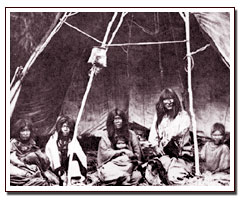 |
By
Wyatt Buchanan
On
Idaho’s U.S. Highway 95 about 100 miles north of Boise sits
a region inhabited mostly by farmers and ranchers. Indian Valley,
as the area and small community are called, consists of little more
than dairies, a general store, a post office and a church.
The obscurity of this area now hides the fact that the Weiser Indians
lived in and around the region as late as the turn of the 20th century.
The story of this Sheepeater group of Northern Shoshone’s relations
with settlers and their virtual dropping off of the map for nearly
20 years is an interesting element in the history of Idaho’s
Natives.
In their homeland of west central Idaho, the Weiser Indians had much
contact with other tribes as well as white settlers who began moving
into the region en masse in the 1860s. Their history is chronicled
in the book "The Weiser Indians" written by historian Hank
Corless. While other tribes and bands fought with the settlers, the
Weisers, led by Eagle Eye, sought and maintained peaceful relations
with those moving in on Indian land, Corless writes.
The Snake War of 1866-1888, the Nez Perce War of 1877 and the Bannock
War of 1878 strained the relations, however, among Eagle Eye’s
Weisers, the settlers and Idaho territory officials, according to
Corless.
While other tribes went – voluntarily and involuntarily –
to the Lemhi and Fort Hall reservations, Eagle Eye resisted. He and
the Weisers did reluctantly go to the Malheur Reservation in Oregon,
but left after less than one year in the spring of 1878.
In the Bannock War that same year, Eagle Eye was falsely reported
to be killed, according to the late Merle Wells of the Idaho Historical
Society.
"That false report helped him considerably during his later career,
because hostile army authorities ceased to look for him, and he was
able to disappear with his Weiser survivors into Idaho’s mountain
wilderness," Wells writes in a foreword to Corless’ book.
Eagle Eye and the remaining Weisers lived in the Indian Valley area,
though several military contingents were sent to root them out and
take them to Fort Hall, Corless writes. This was somewhat successful,
but Eagle Eye and his immediate family remained in the region, settling
near Timber Butte in the Dry Buck Valley.
"When McCall started becoming populated, they moved back (toward
central Idaho) and became the Sheepeaters," said Lonnie Racehorse,
who lives at Fort Hall and has studied the history of tribes in the
southwest part of the state.
|
 |
 |
| Courtesy
of Idaho Historical Society |
Corless says a few white settlers lived in the area, with
whom the Weisers maintained close relations.
A few of those settlers apparently intermarried with the Indians,
Racehorse said.
"Two families lay claim to being Indian up there," he
said. When he worked in Boise, members of those families visited
Racehorse and he said their Indian facial features were apparent.
The life of obscurity was not lost. In 1892, two years after Idaho’s
founding, a surveyor stumbled upon the camp and brought attention
to the peaceful coexistence of settlers and Indians. In fact, Corless
writes, the Weisers had changed their lifestyle to match that of
the homesteaders. Few people knew the Indians were the Weisers headed
by Eagle Eye, who was presumed dead, Corless writes.
Coexistence was also fleeting. In 1896, Eagle Eye died. In 1897,
the headman of the homesteaders died. Corless says these changes
led to other homesteaders complaining to Idaho Sen. George L. Shoup
about the Indians, who sent envoys to the Weisers.
The Indians stayed for several more years, "but reluctantly,
and for reasons unknown, the Indian families gave in," Corless
writes. He says they were the last of Idaho’s Indians to submit
to reservation life, as they went first to the Lemhi Reservation
and eventually to Fort Hall, where descendants still live today. |
 |

